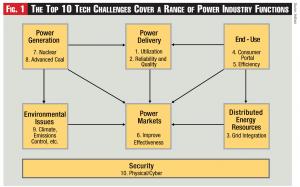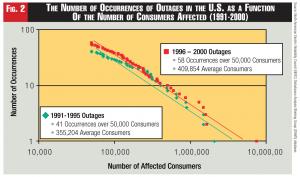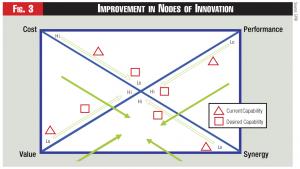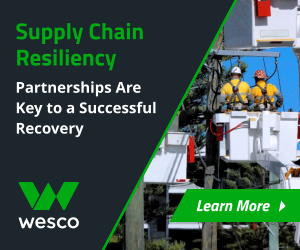Innovation must play a key role in each company.
Clark W. Gellings is vice president of innovation at the Electric Power Research Institute (EPRI). Contact him at cgellings@epri. com. Steve Hoffman is CEO of Hoffman Marketing Communications Inc. Contact him at steve@hoffmanmarcom.com.
The electric power industry is at a crossroads, and the chosen path will have significant economic and social ramifications for decades to come. The industry faces serious technological challenges in each major part of the electricity value chain—from power production to power delivery and end-use. At the same time, cross-cutting issues such as the need to increase the resilience of the power system to security threats and the ongoing need to mitigate the impact of electricity production, delivery, and use on the environment pose formidable difficulties.

Yet, each challenge presents an opportunity. Meeting these challenges will necessitate the upgrade of our aging electricity infrastructure, which will improve the reliability and quality of power delivered to end-users. This, in turn, will improve economic productivity via reduced outage costs, fewer disruptions to sensitive equipment, and other economic benefits. Similarly, requisite advances in consumer connectivity, end-use energy efficiency, and more effective power markets will enable a range of consumer services, lower energy costs, and reduce environmental impacts. Advances in power production also promise tremendous benefits. Cleaner-burning fossil power plants will reduce emissions and sequester carbon dioxide to minimize global climate impacts, making more efficient use of resources.
Figure 1 classifies the top 10 utility technology challenges, using traditional categories, but all unified by one concept: innovation.
Challenge 1 Improve Utilization of Power-Delivery Assets
Technological innovation can help us make better use of what we have. The electric power industry is the most asset-intensive industry in the world. The value of U.S. transmission and distribution assets alone exceeds $350 billion. Upgrading this tremendous asset base to extend its life and enhance its capabilities is one of the most pressing needs the industry faces.
One way to improve power-delivery asset utilization is to increase transfer capacity using existing rights of way. On transmission systems, technology improvements that promise this capability include increasing the voltage, reconfiguring conductors into a more compact arrangement, using high ampacity conductors, and installing high temperature superconducting cables. The high ampacity conductors feature composite or carbon fiber cores, providing higher current-carrying capability. Under high rates of power flow, their greater strength and lighter weight compared with typical conductor cores reduce sag at high temperatures. This allows greater loading of lines that are now clearance limited or thermally constrained.

In addition, the new conductors are more corrosion resistant and promise a longer service life. High-temperature superconducting cables potentially can carry three or more times as much current as conventional cables of the same size and may be suitable for retrofit in some underground transmission conduits and underground transmission rights of way.
Another way to improve utilization of existing power-delivery assets is to monitor equipment operation, enabling real-time rating of facilities. Transmission-system technologies that can accomplish this include wide area measurement systems (WAMS), dynamic thermal circuit rating (DTCR) systems, video-sag monitoring, and topology estimators. For example, DTCR uses real-time information about weather, load, temperature, line tension, or line sag to estimate actual thermal limits (rather than static limits based on worst-case weather conditions), thus allowing higher thermal capacity of transmission lines and substation equipment. This capability can be extended by monitoring the actual conductor sag in real time using sensors mounted on a transmission tower.
Challenge 2 Improve Power System Reliability and Address Power Quality
Two important motivations for upgrading the aging power delivery infrastructure are to improve power-system reliability and address the issue of power quality. Although the most visible recent motivation to improve system reliability may have been the Aug. 14, 2003, U.S./Canadian blackout, the hard fact is that the number of people affected by outages is rising (see Fig. 2, p. 49). Arresting this rise and mitigating wide-area blackouts will require technological advances in more than a few areas. Congestion on transmission lines can be mitigated by optimizing system-operating methods, increasing system capacity, managing aging system assets systematically, and planning for the long term. At the same time, efforts to increase the reliability of individual components can complement methods of increasing wide-area reliability via system control and protection.
Power electronics-based controllers—one of the most successful power-delivery technologies developed collaboratively in the industry—promises an even larger role in enhancing reliability. And fourth-generation controllers using either Insulated Gate Bipolar Transistor (IGBT) or Insulated Gate Commuted Thyristor (IGCT) power electronic devices as valves promise further to reduce the cost and increase the functionality of power electronics-based controllers. Further down the road, the silicon-based thyristors used in current devices can be replaced with thyristors based on wide bandgap semiconductor materials, such as silicon carbide, gallium nitride, or very thin-film diamond materials.

The bigger picture involves more than just power controllers. These devices will be only one part of a broader system, an intelligent grid that includes automated capabilities to optimize the performance of the system, respond to disturbances instantly to minimize impact, and restore the system after a disturbance. The basic building blocks include advanced sensors, enhanced computational ability, pattern-recognition software, and these controllers.
The sister of power reliability is power quality. In applications from manufacturing assembly lines to home appliances, microprocessors now number more than 12 billion in the United States alone. These digital devices are highly sensitive to even the slightest disruption in power quality—an outage of less than a fraction of a single cycle can disrupt performance—and they are sensitive to variations in power quality due to transients, harmonics, and voltage surges and sags.
Improving power quality may require a two-pronged, technology-based approach. On the one hand, the ability of end-use devices to tolerate power-quality fluctuations can be enhanced using small embedded ultra-capacitors or filters. On the other hand, the ability to deliver higher quality power can be enhanced through the use of self-sufficient microgrids and other means. Tackling this problem from both directions will help reduce the very high cost of degraded power quality.
Challenge 3 Integrate Low-Cost Distributed Energy Resources Into the Power-Delivery System
The concept of the microgrid merits additional consideration. A microgrid can be designed to continue to operate when dropped from the power-delivery system as a self-sufficient entity. As a “dispatchable island” in the overall power-delivery system, microgrids can be used to reduce the capacity rating required by some transmission facilities.

A microgrid can play this role only if it includes some form of small generation and storage sources within it. Such distributed energy resources (DER) promise benefits for both microgrids and the broader power-delivery system—benefits that unfortunately have not yet been realized in significant levels. The reason is that much work remains to be done to make DER a widespread reality. A major challenge is to develop interconnection standards and requirements related to integrating DER with existing power-delivery systems, and new sources such as wind energy and photovoltaic devices. The effects of DER on system performance, especially at high penetration rates, can be determined through real-world testing and demonstration projects. Careful studies also may reveal how market structures can provide more meaningful price signals that realize the full potential value of DER.
Advances in storage technologies dramatically will improve the utilization of DER. Fast-response energy storage devices could be used with power electronics-based controllers to provide ride-through capability for transients and brief outages, as well as providing lower-cost solutions to specific types of transmission bottlenecks. One promising storage technology is superconducting magnetic energy storage (SMES), which is available commercially on a limited basis in small sizes. These devices respond to disturbances in less than one alternating current (AC) cycle and provide ride-through capability for multi-second outages affecting sensitive consumer uses. Advanced batteries, flywheels, and ultra-capacitors also are potentially significant storage options for transmission and distribution applications.
Challenge 4 Enable Consumer Portals
The ultimate beneficiaries of high levels of power reliability and power quality are, of course, consumers. But in this age of rapid technological advance, consumer expectations are very high. They want more than just reliable power; studies show that consumers are interested in installing and optimally operating distributed-energy resources, investigating ways to reduce energy costs, and gaining other energy related capabilities. Other services that would benefit consumers include remote monitoring of homes, monitoring of indoor air quality, and diagnosing and performing maintenance on various home appliances. While each of these services can be performed by separate capabilities and service providers, an innovative consumer portal can be the central integrating piece of technology that enables all of these services (and many others).
A consumer portal is a combination of hardware and software that enables two-way communication between energy service organizations and the consumers’ facilities, including equipment within the consumers’ premises. A portal can facilitate consumer participation in demand-response programs, enable automatic meter reading, and broaden consumer interaction with the energy supplier in areas such as billing, reviewing energy consumption, reporting trouble, and selecting a service provider. More motivated consumers could optimize their energy use by downloading price forecasts, computing energy efficiency of appliances, controlling distributed energy resources at multiple sites, and submitting bids to an energy market. On the other side of the meter, a portal helps distribution companies monitor equipment, detect and isolate outages, shed load with finer control, better optimize power quality, monitor distributed energy resources, and better control voltage. Hence, a portal can reduce energy costs for consumers and reduce various costs for distribution companies, while improving power quality for consumers and offering new revenue opportunities for service providers. It promises one of the biggest win-win propositions in the long history of electricity.1
Challenge 5 Increase End-Use Energy Efficiency
One of the benefits of a consumer portal—reduced energy consumption and costs—calls for closer scrutiny. The reason is that the benefits of increasing energy efficiency permeate throughout the electricity supply chain and beyond. When end-use devices consume less power, less power generation is needed (which reduces corresponding environmental impacts), less power-delivery system capacity is needed, monthly energy costs decrease, inflation is held in check, and more funds become available for investment (thus stimulating the economy). For these reasons, end-use efficiency often is viewed as a resource. Tapping into this resource, many end-use consumers already have benefited from installing more energy-efficient equipment in their homes, offices, commercial establishments, and factories. Yet, a tremendous opportunity for further savings remains.
Traditional low-hanging fruit in this area, such as lighting, motors, and heating, ventilating, and air conditioning (HVAC) systems continue to consume far more energy than necessary. Artificial lighting alone consumes 20 to 25 percent of all electric energy in developed countries. A variety of innovative technologies can reduce lightings’ share of total electricity consumption, while providing additional benefits of increased worker productivity. At the same time, the opportunities for savings in the industrial sector are as widespread and diverse as the industrial facilities themselves. For example, in the energy-intensive aluminum industry, great energy savings are possible through advances in the Hall-Heroult electrolytic reduction process (the method of aluminum reduction or smelting currently used in the industry accounts for the largest portion of energy use). Across various industries, opportunities exist in the form of high efficiency motors, increased waste heat and material recovery, improved controls, increased cogeneration capacity, expanded use of thermal energy storage, and improved energy management practices.2
Challenge 6 Improve the Effectiveness Of Power Markets
Power markets underpin all of the challenges discussed so far, including the power-delivery system, reliability, quality, distributed resources, consumer needs, and end-use devices. While markets have existed in various industries for a long time, power markets are relatively new, and we clearly do not yet know how to implement effective power markets in all cases.
The debacle in California a few years ago demonstrated the consequences of improperly designed markets. Yet power markets are being redesigned around the world, in some cases with only limited understanding of the implications of changes that are proposed or implemented.
Simulation tools offer opportunities to stress-test market designs before they are implemented. In this “wind-tunnel” approach, such tools accurately can model the complex interactions among various market participants, individual power markets, and the electricity infrastructure. Particular areas of market design that benefit from modeling are bidding strategies, resource adequacy, market power, and market performance.
Using sophisticated agent-based simulations, these models can be used upfront (before the new markets are launched) to evaluate designs, or after a new market launch to fine-tune designs and test market enhancements.
This same concept can be applied across an entire region to evaluate cross-jurisdictional or “seams” issues. In North America, for example, regional transmission organizations (RTOs) are being established alongside other RTOs, large utilities that remain vertically integrated, public power agencies, and other entities. In addition, careful simulation and modeling would help to ensure efficient, broad transmission planning over the long term (10 to 25 years). The latter will be particularly useful when evaluating ways to provide incentives for long-term investments in transmission infrastructure, which has been lagging in recent decades.
Challenge 7 Capitalize on the Opportunity of Next-Generation Nuclear
Another critical area for technological innovation is power generation. Nuclear power provides a significant portion of electricity generation throughout the world. Meeting the electricity needs of nearly 1 billion people in more than 30 countries, the nuclear-power industry has demonstrated that electricity can be reliably produced without contributing to global climate change or emitting other significant pollutants. In fact, a number of industrialized nations rely on nuclear power to provide half or more of their electricity.3
The latest designs of advanced light water reactors are being deployed in Europe and Japan. For nuclear power to play a larger role in power generation, these so-called Generation III reactors need to be deployed in the United States. Beyond these, another new generation of designs is needed. The challenges to developing these designs are formidable. Next-generation nuclear energy systems must be safe, reliable, secure, and environmentally friendly. They must be low-cost compared with alternatives, and pose financial risk comparable to that of alternatives. Moreover, advanced designs must minimize production of nuclear waste and enable its effective management.4
Realizing that commercial deployment of these designs requires a sustained high level of technological innovation, funding, and effort over a period of decades, the U.S. Department of Energy’s Generation IV Nuclear Energy Systems Initiative leads a group of 10 countries to jointly fulfill these technology goals. Early efforts have focused on what the group calls the Very High Temperature Reactor (VHTR) because of its potential to safely produce electricity and hydrogen at low cost with zero emissions of greenhouse gasses.5
Challenge 8 Optimize Use of Coal Resources Via Advanced Coal Generation
While nuclear power plants meet significant power needs, coal-based plants are the workhorse of electric generating systems around the world. In the United States, one-half of all electricity is generated from coal, the only fossil fuel the nation has in ample, long-term supply. Despite the abundance and consistently low cost of coal as a generating fuel, few coal-fired power plants have been built around the world in the past decade, except in Asia. Instead, lower capital costs, quicker construction, and more straightforward permitting have favored natural gas-fired plants. Today, high natural-gas prices and forecasts that they will remain high are making the economics of coal power appear more attractive. But significant barriers to broader use of coal exist, and technical innovation is a key component in removing these barriers.6
One barrier is cost. Electricity from initial integrated gasification combined-cycle (IGCC) coal plants without carbon dioxide (CO2) capture and storage will cost 15 to 20 percent more than electricity from conventional coal power plants with sulfur dioxide (SO2) and nitrogen-oxide (NOx) emission controls.
To reduce these costs and accelerate commercial use of advanced coal technologies, EPRI has initiated a collaborative program, called “CoalFleet for Tomorrow,” that includes 40 participants representing more than one-half of U.S. coal-fired generation. Innovative coal-plant configurations, including IGCC, ultra-supercritical pulverized coal, and supercritical circulating fluidized-bed combustion, promise to boost availability or lower heat rate and emissions in the near term, and ultimately lead to the commercial introduction of next-generation plant designs that are approximately 20 to 25 percent lower in capital costs.7
Challenge 9 Mitigate Environmental Impacts
Closely related to the coal generation challenge discussed above is the greatest environmental challenge facing the electric power industry: the long-term problem of global climate change. While this is a politically contentious issue that will involve a broad range of social and institutional changes and solutions, it is also a technical issue. Technological innovation will go a long way toward mitigating anthropogenic emissions of greenhouse gasses into the atmosphere around the world.
While few scientists refute the convincing evidence that human activities are beginning to affect global climate, more uncertainty exists as to the appropriate combination of technologies to reduce this impact. Clearly, a range of technologies will be needed to capture, transport, and sequester CO2 and other greenhouse gasses emitted from fossil power plants. The expected continuing global reliance on coal and other fossil fuels places a premium on technological innovation in this area.
Recently enacted regulations now bring another environmental issue to the forefront that will require substantial technological innovation to address. The nation’s 600 or so large coal-fired power plants currently emit about 40 percent of total domestic emissions of the hazardous material mercury. After some 15 years of study, the U.S. Environmental Protection Agency issued final rules on March 15, 2005, for regulating mercury emissions from these plants. The new regulations require a reduction of mercury emissions by 70 percent, phased in over the coming 12 years. As yet, no technology designed specifically to control mercury in coal plants is in use anywhere in the world, or even has undergone long-term testing. Some improvements can be achieved by modifying existing SO2 and NOx control devices, but new approaches will be required to meet the final 2018 emission limits.8
Challenge 10 Increase the Resilience of The Power System to Security Threats
The electricity supply and delivery network represents society’s most critical infrastructure, not only because of the service it provides and activities it enables directly, but also because it enables all other critical infrastructures: water, communications, fuel, transportation, finance, and others. Hence, perhaps like no other issue in this list, security cuts across the electric power industry, and beyond.
Increasing the resilience of the power system to security threats is a multi-faceted problem. Both physical security and information security threats must be considered. Threats from many directions—from international terrorists to disgruntled employees—must be addressed. Adding to the complexity is the fact that most aspects of the power system were not developed with security threats in mind. This means that an entire critical infrastructure, valued at hundreds of billions of dollars and crucial to the proper functioning of all industries, is vulnerable to a broad range of attacks from many directions.
Institutional and policy issues will play a major role in finding solutions in this area. Yet the role of technological innovation is particularly acute here, especially on the cyber side of the threat, addressing the diverse areas of vulnerability assessment, penetration testing, and intrusion detection and prevention, among others.
Figure 3 illustrates the extent to which innovation is needed in the collective impact of the challenges discussed here. It reduces the attributes of innovation to cost, value, performance, and the degree to which they have a multiplying effect or synergy with the overall performance of the power system.
Endnotes:
1. EPRI, “IntelliGrid, Consumer Portal Stakeholder FAQ and Survey,” 2005.
2. “Efficient Use and Conservation of Energy in Encyclopedia of Energy Sciences, Engineering and Technology Resources,” Clark W. Gellings editor and coauthor, in Encyclopedia of Life Support Systems (EOLSS), Developed under the auspices of the UNESCO, EOLSS Publishers, Oxford, UK, [http://www.eolss.net], 2004.
3. U.S. Department of Energy, Office of Nuclear Energy, Science and Technology, “Generation IV Nuclear Energy Systems Initiative,” fact sheet, February 2005, http://gen-iv.ne.doe.gov/documents/geni.pdf.
4. Ibid.
5. Ibid.
6. EPRI, “Coal-Based Generation at the Crossroads,” Taylor Moore, EPRI Journal, Summer 2005.
7. Ibid.
8. EPRI, “Mercury Control for Coal-Fired Power Plants,” Paul Haase, EPRI Journal, Summer 2005.




